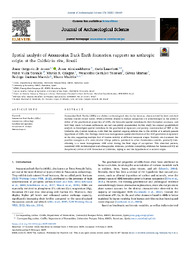Embrapa Solos
 Busca de Publicações
Busca de Publicações
Spatial analysis of Amazonian Dark Earth formation supports an anthropic origin at the Caldeirão site, Brazil.
Autoria: SOUZA, J. G. de; ALCAINA-MATEOS, J.; LANCELOTTI, C.; VIDAL-TORRADO, P.; CALEGARI, M. R.; TEIXEIRA, W. G.; MARTINS, G. C.; MACEDO, R. S.; MADELLA, M.
Resumo: Amazonian Dark Earths (ADEs) are distinct archaeological sites in the Amazon, characterized by their enriched nutrient content in soil layers. While activities related to human occupation are acknowledged as the primary driver of the geochemical properties of ADEs, the intra-site spatial variations in their formation processes, and how they relate to human settlement, are not completely documented. In this study, we employ geostatistical analysis to investigate spatial variations in the geochemical signature and pottery concentration of ADE at the Caldeirão site, Central Amazon, a site that has sparked ongoing debates due to the revival of a natural genesis hypothesis of ADEs. Our findings reveal non-homogeneous spatial distribution of the ADE geochemical signature at the site, suggesting multiple foci of human activity at different temporal stages. Notably, we document the possible emergence of a semi-circular village pattern, prevalent in other Amazonian contexts, gradually transitioning to a more homogeneous ADE cover during the final stage of occupation. This observed pattern, consistent with archaeological and ethnographic evidence, provides compelling evidence for human activity as the primary driver of ADE formation at Caldeirão, laying to rest the hypothesis of a natural origin.
Ano de publicação: 2025
Tipo de publicação: Artigo de periódico
Unidade: Embrapa Solos
